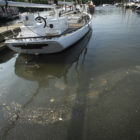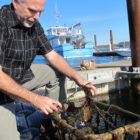I-Team In-Depth
Dead Fish, Condoms, Brown Foam: Sewage Has Chokehold On Black Rock Harbor
|
On April 25, 2018, Patrick Clough walked onto a dock at Fayerweather Yacht Club on Black Rock Harbor in western Bridgeport. He looked down. Swirling around the dock was a brown, foamy slick. Women’s sanitary products and other objects floated in it. He posted a photo of the discharge on two Black Rock neighborhood Facebook pages, writing “This is disgusting.”
A week before Clough captured that photo, equipment malfunctioned at the Bridgeport West Side Water Pollution Control Facility.


